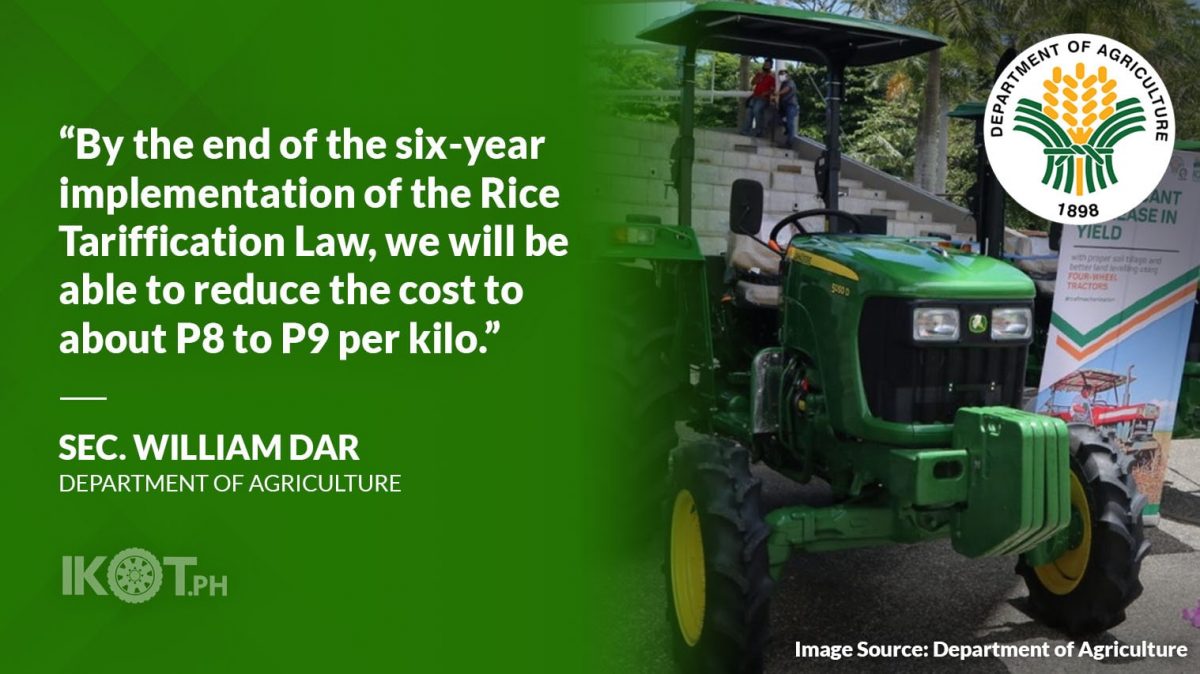Ushering in the third year of implementation of the Rice Tariffication Law (RTL), about one million farmers will receive P15-billion worth of farm machinery and equipment, enabling them to mechanize their operations and reduce the average cost of producing rice.
“The continued implementation of the Rice Competitiveness Enhancement Fund (RCEF) as provided under RTL is paving the way to this favorable development onto making Filipino rice farmers globally competitive,” Agriculture Secretary William Dar said.
The RTL or Republic Act 11203 allots P10 billion yearly from tariffs of imported rice for six years, from 2019 to 2024, for the RCEF program aimed at enhancing the competitiveness of the Philippine rice industry.
One-half or P5B of RCEF is allotted for farm mechanization, P3B for inbred certified rice seeds, and P1B each for credit, training and extension.
During the first two years, the DA through the Philippine Center for Postharvest Development and Mechanization (PhilMech) has procured 15,918 units of various farm machinery and equipment, of which 55 percent (%) or 8,702 have already been distributed to 679,486 farmers, belonging to 3,804 FCAs in 57 provinces, where the RCEF program is implemented, broken down as: in 2019 – 268,363 farmer-members of 1,698 FCAs; and in 2020, a bigger bulk of 411,123 farmers from 2,106 FCAs.
This year, PhilMech said it will procure 5,098 units, and distribute these to 1,600 FCAs with 284,800 farmer-members.
Of the total farm machinery and equipment, 2,574 units are for land preparation like four-wheel and one-hand tractors, and attachments like tillers, totaling P1.7B; 496 units for crop establishment like transplanters and seeders, worth P500 million; and 2,028 units of post-harvest equipment like mechanical harvesters, threshers and milling machines, worth P2.8B.
PhilMech studies show that mechanizing rice production operations, from land preparation to harvest, can reduce the production cost of palay (paddy rice) by P2 to P3 per kilogram (kg).
Currently, the cost of producing palay in the Philippines is at P12.72 per kilo, while it is P6.22 in Vietnam and P8.86 in Thailand, according to studies by DA’s Philippine Rice Research Institute (PhilRice).
In a report to Dar, DA-PhilMech Director Baldwin Jallorina assured that the distribution of farm machinery and equipment to rice farmers’ groups will continue despite the COVID-19 pandemic.
“2021 is pivotal as it is mid-way of the six-year implementation of the RTL and RCEF.”
“We at PhilMech believe that 2021 is pivotal as it is mid-way of the six-year implementation of the RTL and RCEF, particularly the farm mechanization and three other components,” Jallorina said.
“We are confident that by the end of the six-year implementation of the RTL and RCEF, coupled with our initiatives under the Philippine integrated rice program, we will be able to reduce the cost to about P8 to P9 per kilo, thus making us at par with our counterparts in ASEAN,” the agriculture chief said.
For her part, Senator Cynthia Villar, the main RTL author, hailed the progress of the RCEF program implementation.
“Our hard work is finally coming into fruition.”
“Our hard work is finally coming into fruition. Last year, despite the onslaught of super typhoons that battered the country’s agriculture industry, the Philippines recorded the highest palay production of 19.44 million metric tons. This is a 3% increase from the previous year, which means we are almost there in terms of rice self-sufficiency,” said Villar, who chairs the Senate committee on agriculture and food.
“Let us celebrate this milestone together, and use this achievement as an inspiration to gather our strength to deliver more benefits to our rice farmers, who, together with other farmers of crops and livestock, form the backbone of our agriculture industry,” the veteran legislator stressed in a virtual message during the second anniversary of RTL recently.

